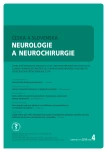Diastematomyelia in Adults – a Case Report
Authors:
V. Novák; L. Hrabálek; M. Vaverka; M. Halaj
Authors‘ workplace:
Neurochirurgická klinika LF UP a FN Olomouc
Published in:
Cesk Slov Neurol N 2015; 78/111(4): 486-489
Category:
Case Report
Overview
Diastematomyelia is a rare congenital defect, a type of spinal dysraphisms, often associated with the tethered cord syndrome. Diastematomyelia is formed by the two halves of the split spinal cord that each has own dural sac separated by a rigid or fibrotic septum. This defect is mainly diagnosed in children. Pain is the dominant symptom in adult patients. The authors present a case of a woman aged 44 years with diastematomyelia who complained of chronic back pain and progressive weakness in her legs. In this patient, laminectomy was performed, the spinal cord released and the dural sac restored. After the surgery, the patient had no neurological deficits and reported significant pain relief.
Key words:
diastematomyelia in adults – tethered cord syndrom – split cord malformation
The authors declare they have no potential conflicts of interest concerning drugs, products, or services used in the study.
The Editorial Board declares that the manuscript met the ICMJE “uniform requirements” for biomedical papers.
Sources
1. Pang D, Dias MS, Ahab‑ Barmada M. Split cord malformation. Part I: a unified theory of embryogenesis for double spinal cord malformations. Neurosurgery 1992; 31(3): 451– 480.
2. Huang SL, He XJ, Wang KZ, Lan BS. Diastematomyelia: a 35‑year experience. Spine 2013; 38(6): E344– E349. doi: 10.1097/ BRS.0b013e318283f6bc.
3. Iskandar BJ, Fulmer BB, Hadley MN, Oakes WJ. Congenital tethered spinal cord syndrome in adults. Neurosurg Focus 2001; 10(1): e7.
4. Anderson FM. Occult spinal dysraphism: a series of 73 cases. Pediatrics 1975; 55(6): 826– 835.
5. Hoffman HJ, Hendrick EB, Humphreys RP. The tethered spinal cord: its protean manifestations, diagnosis and surgical correction. Childs Brain 1976; 2(3): 145– 155.
6. Pang D. Split cord malformation. Part II: clinical syndrome. Neurosurgery 1992; 31(3): 481– 500.
7. Häckel M, Beneš V. Diagnostika a léčba tethered cord syndromu – syndromu fixované míchy. Neurol Prax 2004; 5(1): 39– 41.
8. Horn F, Babala J, Studený S, Smrek M, Pevalova L, Kirnák Jet al. Diastematomyelia and the tethered spinal cord syndrome. Case report. Rozhl Chir 2001; 80(5): 242– 245.
9. Beneš V jr, Beneš V sr. Syndrom fixované míchy – tethered cord syndrome. Cesk Pediatr 1986; 41/ 78(10): 608– 611.
10. Cheng B, Li FT, Lin L. Diastematomyelia: a retrospective review of 138 patients. J Bone Joint Surg Br 2012; 94(3): 365– 372. doi: 10.1302/ 0301‑ 620X.94B3.27897.
11. Harwood‑ Nash DC, McHugh K. Diastematomyelia in 172 children: the impact of modern neuroradiology. Pediatr Neurosurg 1990– 1991; 16(4– 5): 247– 251.
12. Gan YC, Sgouros S, Walsh AR, Hockley AD. Diastematomyelia in children: treatment outcome and natural history of associated syringomyelia. Childs Nerv Syst 2007; 23(5): 515– 519.
13. Mahapatra AK. Split cord malformation – a study of 300 cases at AIIMS 1990– 2006. J Pediatr Neurosci 2011; 6 (Suppl 1): S41– S45. doi: 10.4103/ 1817‑ 1745.85708.
Labels
Paediatric neurology Neurosurgery NeurologyArticle was published in
Czech and Slovak Neurology and Neurosurgery

2015 Issue 4
Most read in this issue
- Therapy of Pudendal Neuralgia – Five Years of Experience
- The Contribution of Magnetic Resonance Imaging to the Diagnosis of Epilepsy
- Experimental Treatment of Spinal Cord Injuries
- TLIF Technique for Treatment of Foraminal Lumbar Disc Herniation in Isthmic Spondylolisthesis
